|
An
article covering a major R/C competition in one of today's modeling
magazines would be 90% color photos and 10% text. In 1967 it was
just the opposite, as this coverage of the "Fifth World Championships
of Air Gymnastics for Remote Controlled Aircraft" shows - and there
is no color to be found. Maybe the old adage about a picture being
worth a thousand words balances the equation. 43 pilots represented
17 nations on the French island of Corsica. Phil Kraft and his own
design Kwik Fli IV ruled the day. France and Germany took second
and third place, respectively. If you like reading about how the
early pattern radios, airplanes and engines were combined to wow
the crowds, this one is for you. Fifth RC World Champs
Seventeen nations - and 43 pilots - vied in hotly contested meet
at Corsica, sponsored by the Aero Club of France. Using models powered
by the big 60's, but distinctly smaller than those flown by the
competition, the United States' consistent performance gained both
individual and team honors. By Howard McEntee
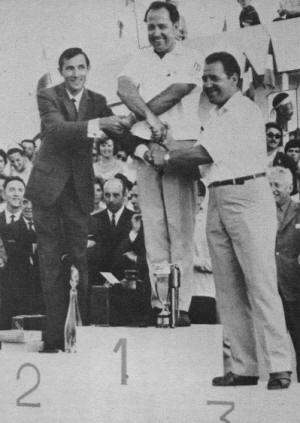
The happy winners: Phil Kraft, USA, first; Pierre Marrot, France,
second; and Kurt Bauerheim, West Germany, third.
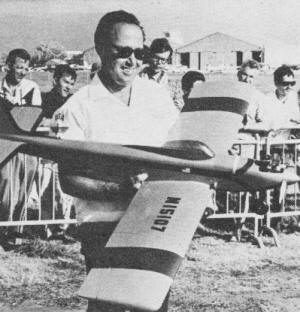
The winning combination: Kraft and Kwik Fli IV.
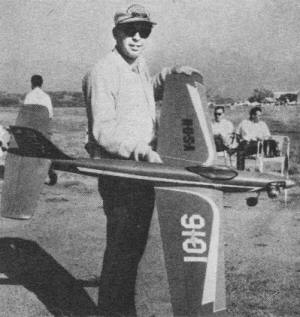
Doug Spreng and his fourth-place Twister.
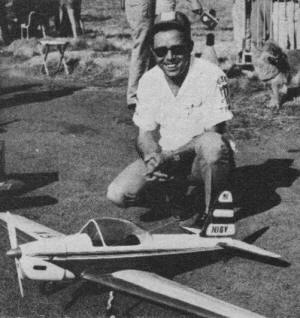
In tenth place, Weirick with scale Chipmunk.
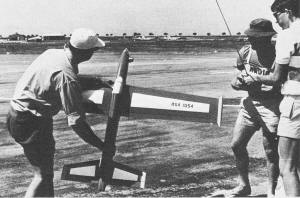
The South African team was an example of truly amateur enterprise;
none has any connection with the trade. Chris Sweatman, Rich
Brand, and Johnny Wessells.
Fifth World Championships of Air Gymnastics for Remote Controlled
Aircraft; this impressive title is a free translation of the French
wording on the cover of the official booklet handed out to all who
arrived at the French island of Corsica on June 21, ready for what
proved to be the largest of the five RC World Championships held
so far. A large majority of those attending the affair spent the
night of June 20 at the French seaport resort of Nice; around noon
Wednesday all hands gathered at a central point for a reception
tendered by the mayor, then piled into buses for a trip to the Nice
airport. Reception, bussing and the airlift to Corsica were part
of the "package" arranged by the Championships organizers, which
also included the five day stay in Corsica, board and lodging and
transportation back to Nice on June 27th. This competition
had its ups and downs. On the "up" side was a full week of perfect
flying weather - warm to hot days (on Sunday, the early morning
"heat reminded us of the Nats at Dallas!), cool nights, generally
low winds. Worst of the "downs" was serious interference on Friday,
June 23rd, first day of official flying: this was, in fact, the
first such interference which has ever been experienced at an RC
Championships - more on this later. Upon arriving at the
very modern Campo dell-Oro airport of Ajaccio, Corsica, a first
impression was of the fine climate (especially appreciated by many
travelers from parts of the U.S. who had experienced a cold and
wet spring - which had also afflicted England and much of Europe).
Next we were awed by the mountainous terrain, some of the higher
peaks of which appeared to carry remains of winter snow! The airlift
from Nice was via two planes; one was a huge double-decker Breguet
937, a four propeller job with ample room for the many model cases
which had collected at Nice. The upper deck of this plane had seats
for many of the RCers, while others embarked on an Air France Caravelle
for a considerably faster and more luxurious trip. Information pouches
were handed out to all at Campo dell'Oro, after which buses carried
all hands to their lodgings. The vast majority had a trip of about
seven miles along a very narrow and winding road, terminating at
the "Marina-Viva," a large resort which in the States would be termed
a motel. Though a little early in the vacation season, there were
already a hundred or so persons at the Marina, to which were added
some 150 or so RC flyers, officials and supporters. The latter category
includes those from any country who have no direct connection with
the meet, but just a love of flying and a desire to root for the
"home team" - wherever home might be. Even though interference
caused considerable delays, however, it was found possible to finish
the first official round of flying on Friday, June 23, not long
after 6 p.m.; start of flying was therefore postponed till 8 a.m.
on June 24th and 25th. While there is little model plane
activity on Ajaccio, there is a very active flying club; the attractive
headquarters building of the Aero Club de la Corse was a mecca for
all participants during the meet, and one of the two club hangars
was the main pit and storage area for planes. U.S. Team
members had no problem getting their large model boxes to Frankfurt
- terminus of the over-Atlantic airlift arranged through AMA. But
here problems arose; Wierick and Spreng found that no planes going
to Nice had room enough to carry the model boxes! (Kraft had shipped
his box directly from California to Ajaccio - which was fine, except
for the fact the box arrived at the airport at the last moment,
and just in time for the practice flying on June 22!). Through intercession
of various airline officials, the two flyers were allowed to take
their two planes apiece onto the aircraft sans boxes, a most unusual
concession. Incidentally, while checking their boxes at Kennedy
Airport in New York the boys had proof that RC modelers are literally
everywhere; printed on a corner of one box was a message saying
"Win the World Championships with these models, then give 'em to
us" and signed the L.I.D.S.- a prominent club that evidently covers
Long Island like a blanket! Due to uncertain transportation
between the Marina and the flying field, many entrants, including
the U.S. team, rented their own cars. Upon arrival at the Marina,
it was found that the management had banned battery charging! Doubtless
completely unfamiliar with model planes, the manager probably envisioned
a heavy-duty auto battery charger running in most every room, to
put a heavy drain on his meager voltage supply. It's likely a lot
of "bootleg" charging went on that first night! There were ample
charging facilities at the work hangar, of course. As is
usual practice at such meets, a full day of practice was allowed,
June 22. and each member of the 17 teams present got approximately
15 minutes for test flying; 43 pilots started the meet. In a determined
effort to come out on top, the German Team had arrived at Ajaccio
some days earlier, and were doubtless very familiar with the field
and the flying conditions by the time the meet started. Fortunately,
they had brought with them a most complete monitoring system to
check for interference. The setup even included an oscilloscope
for observing incoming signals, and a tape machine for recording
same, if desired. All this equipment was in a small station wagon,
but was used only on and off during the Thursday practice day. It
turned out that this was the only monitoring equipment at the meet;
apparatus which had been requested from the French government failed
to arrive in time for the meet (as did some other essentials, such
as meal tickets!). Since there is no real contest pressure
during practice day, Press photogs try to take as many photos as
possible then. This led to the hassle that seems to come early in
every World Champs (and usually at every U.S. Nationals tool), and
soon the Press representatives found themselves confined some 100
yards or more from the flying spot - an impossible situation. As
is usually the case this misunderstanding was eventually resolved
to the satisfaction of all - but why can't these things be anticipated
beforehand and suitable arrangements made before many hard feelings
are generated? During practice it was feared that many teams
would not have sufficient fuel to get through the meet. Our own
team had plenty, and Manager Jerry Nelson offered to supply anyone
who ran short - a gesture that was most appreciated. During
practice day we had a good chance to look over planes and equipment,
as well as to assess the level of competition. It was apparent that
this was to be a "proportional Championships," for our data showed
that every entrant flew propo in the meet (some may have had reeds
in their second planes, of which there are not complete records).
Out of 41 flyers, 19 used U.S. equipment of various makes, Bonner
Digimite being most numerous with six users. The German Simprop
system was most numerous in the meet, with ten users. Multi propo
equipment is no longer made in South Africa, and this team used
U.S. apparatus throughout. Digital apparatus is now made in France
(Radio Pilote, being marketed by 2nd place Marrot), and in Sweden
(Micronic - used in Corsica by at least one Swedish team member).
Though there is quite a variety of English propo equipment, all
British team members used U.S. equipment; this team was 100% reeds
at the last World Champs. Not many other flyers had planes
as small as the U.S. team - and many were far larger. There were
several copies of Fritz Bosch's Super Delphin, a really big plane.
Just about every plane was a low winger, except for the Satanus
II of Marrot, and a similar model by his teammate Cousson; these
are shoulder wingers with rather thick airfoil, and Marrot's well-deserved
second place testifies to their flying prowess, at least in the
FAI pattern. As a holdover from the 1965 Championships, there were
a couple of Brooke Crusaders - one modified with a swept wing.
The U.S. Team flew more or less new planes - much different
from those flown in the Eliminations last fall. Winner Phil Kraft
flew a version of his Qwick-Fli, which in fact, sported a three-year-old
wing, but this Mk III model had an upright engine, lower thrust
line, deeper rear fuselage and much larger rudder area than the
Qwick-Fli II. Power was an Enya 60 II, and radio equipment-well,
what do you think!? Fourth place man Doug Spreng had a rather small
taper-wing plane he calls Twister, powered by ST 60, while 10th-placer
Cliff Weirick flew the scale Chipmunk with Veco 61. The latter attracted
a great amount of attention due to its sleek scale appearance. Cliff
used flaps to slow down landing approach and used interesting take-off
technique with only partially open throttle, then opened right up
immediately after the machine broke ground. This helped the model
from nosing over. Engines were just about 100 percent 60-61
(one Fox 59 listed). We counted 11 each of Rossi and ST 60's, and
eight Mercos as the most popular. Many engines were fitted with
mufflers; several countries have mandatory muffler rules, among
them Sweden. However, the Swedish flyers operate in a much cooler
atmosphere and had some overheating troubles in Corsica. Engine
troubles plagued many other entrants as well; in this "sudden-death"
sort of competition (where every single flight counts, and one poor
flight for any reason at all can drop a flyer far down in the standings,
and can cost his team a top place) reliable power is every bit as
important as reliable radio. We noted that a good many competitors
were using the Kavan carburetor, which is gaining quite a reputation
in the U.S. too. The judge rotation system was the same
as inaugurated at Sweden; six judges (plus several alternates in
case of illness, etc.) were kept on duty, with four judging every
flight. After any group of four had judged four flights. two dropped
out and the other two took their places. Overall, this meant that
a judge was generally working for eight flights and off for four.
Order of flying was switched each day too, though the same basic
order was retained for the three official flying days. Thus, on
Friday, flying started with Tonnessen of Norway first; Saturday,
Tonnessen dropped to 20th, and the bottom 19 fivers on the Friday
list were brought to the top. Sunday another such shift was made,
resulting in Kraft flying first. This system worked fine. though
the word soon went out as to which judges were considered "tough"
and vice-versa! But it assured that no fiver would get the same
set of judges twice during the meet. The only real problem was that
when a flyer had a "delay" (which entitled him to a second try at
the end of the round), the same set of judges had to be assembled
as were on duty when he had his original try.
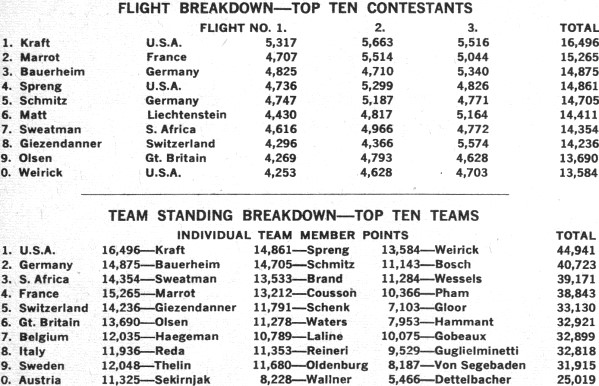
5th R/C World Championships Score Card
The judges came from the U.S. (Maynard Hill), Belgium, West
Germany, Great Britain, Czechoslovakia and France, and are appointed
by the CIAM, the modeling division of the FAI. Similarly selected
were the three jury members, with Walt Good from the U.S., A. Roussel
from Belgium, and Henry J. Nicholls from Great Britain.
Interference raised its ugly head early on Friday, on the flight
of Fritz Bosch, who was second man up. He had gone through eight
minutes of his pattern when it became evident he was in trouble;
he was able to land safely and the German monitoring setup, mentioned
earlier, detected strong interference very close to 26.995 on which
he was flying. The signals evidently came from a long distance,
as they would fade in and out; but when "in," the level was very
high. During the day, the interference would at times register a
stronger signal on the monitor receiver than would the RC transmitter
on the flight line only 150 feet away! All sorts of signals were
picked up -voice, code and so on. Unfortunately, the voices could
never be identified, but it would have mattered little if they could
have been: they doubtless came from much too far away to just call
the interfering station on the phone and ask them to please sign
off so the model meet could continue! This is the first World Championships
which has had any real interference trouble; it is likely to be
even worse two years hence in Germany, since the sunspot cycle will
be at its peak then - and high sunspot activity is what causes worldwide
problems from "skip" signals bouncing off upper atmosphere layers.
But what can you do? As the day wore on, the interference
faded considerably, so that by late afternoon it was not a problem.
Some contestants had been able to fly in their assigned position
in the lineup by shifting to less-bothered RC spots. Others could
not do so for various reasons (some just didn't have the necessary
crystals to do so) and were dropped to the end of the round, when
they flew late Friday afternoon. The fact that the monitoring
equipment was of German origin-and in fact, had been brought to
the field by a German propo maker (Simprop ) - posed some delicate
problems in international relationships. The jury finally solved
this and soothed all ruffled feelings by permanently posting one
of their number (Walt Good) at the monitor. All day Friday, every
transmitter was checked for exact frequency as soon as it was brought
from the Impound tent to the field. It was then switched off, and
the frequency checked. If no serious interference was detected,
a green flag went up, and the contestant could feel safe to fly.
If there was interference on the frequency, Juryman Good recorded
the fact, and made a record of frequency, signal strength, time
and other data at the moment on the tape recorder. With a red flag
up, denoting interference. a modeler was free to decide if he wanted
to take a chance or not (if he did, and got into trouble, he would
not be given a delayed flight). It's a tribute to the monitor
equipment and its operator that not a single crash occurred despite
the heavy interference - though there were several Friday caused
by the usual problems - equipment and pilot trouble. There were
several more crashes on Saturday and Sunday from the same causes,
in heavy contrast to Sweden, when not a single plane crashed during
official flying. A modeler can enter an official protest
to the jury at any time during the meet, of course; during all the
worry over interference on Friday, one experienced flyer felt he
was having unexplained engine speed changes during his flight, even
though no interference could be noted on the monitor. This fact
was taped by Juryman Good, who accepted the protest and the mandatory
payment of ten Swiss francs (about $2.50). It was later reported
that the flyer had changed his throttle servo - and had no further
problems in this line. With the interference dropping rapidly
Friday afternoon, some contestants elected to fly on the most troubled
spots, with no real problems. When it came time for Bosch to take
his delayed flight, all flyers were watching intently, as he could
very well have won the meet. But it was soon apparent that his engine
was sagging badly, and it soon quit during a maneuver! (Later examination
showed a speck of dirt in his fuel line.) It's useless to speculate
"what might have been"; but Bosch got only 810 points for his very
short delayed flight on Friday. His other two flights were well
over 5100 points each; "if" he had scored in the same vicinity on
the ill-fated first day, the German team might well have placed
first. A few hundred more points could have won first place for
him (provided our boys weren't inspired to do ever better than they
did). Unlike 1965, where there was a seesaw battle for first
over the three days of official flying, Kraft jumped to first place
on Friday and was never topped thereafter; he hit 5317, his lowest
score of the three days. He was followed by German flyers Bauerheim
(a veteran of World Championship RC flying) and Schmitz, the latter
a newcomer. Then came Spreng at 5th and Marrot at 6th. Cliff Weirick
was down at 12th. There were some surprises in this round; the South
African team looked very good, with flyers at 6th, 7th and 17th.
And the lone representative from Liechtenstein (first time this
tiny country has entered the World Champs) was a strong 8th in the
field of 42; Wolfgang Matt is only 19, flew a copy of Bosch's Super
Delphin which was only about 2 oz. under the maximum FAI weight
limit! And at that, he lost his landing points for being overtime.
Everyone expected the worst from interference on Saturday
- and there was practically none at all, nor was there on Sunday.
No one could explain why it had vanished so suddenly, as it was
apparent the Friday trouble was caused by a number of stations,
not just one; but that's the way the upper atmosphere often behaves,
as any ham radio operator can tell you. But while there was no interference
from long distance signals, there was some right on the field, as
it finally turned out. The air had seemed clear when Greek entrant
Papaspyros (1967 also was the first year for this country in RC
World Championship competition) was ready to fly late in the afternoon.
But some time after he became airborne, it appeared that he was
having trouble, and the monitor operator called attention to a whistle
that could be heard weakly under the strong sigs from the nearby
Greek transmitter. The red flag was run up immediately, and Papaspyros
was able to get his plane on the ground intact. With his transmitter
off. a rather potent and steady signal could be heard, obviously
a digital transmitter. An immediate search was started for one with
a switch left on. It was finally found - one of two identical transmitters
of flyer Cousson, both on 27.095 - the same as Papaspyros. One other
flyer had been up with no problems between Cousson and Papaspyros,
but on 27.255, so the switched-on transmitter hadn't been noticed
- if it was on at that point. Why wasn't it detected before the
Greek flyer took off? No one can say - but again an alert monitor
operator caught the interfering whistle in time to prevent a possible
crash. By the end of Saturday flying, it became fairly ,evident
how the top places would go - provided the holders of same fared
well on Sunday. Kraft led 2nd placer Marrot (on the basis of two
days scores) by some 700 points, but could still be deposed on Sunday
by the competent French flyer. Spreng was up to 3rd, Bauerheim had
dropped to 6th. Matt still clung to 8th place, while Weirick had
risen to 9th. France and South Africa still looked good in team
placings after U.S. Team Manager Jerry Nelson's charges, with Germany
now in 4th, due to Bosch's strong second flight, and his jump from
40th to 30th place.
Sunday
gave promise of extreme heat, and the early morning was practically
windless. Fortunately, a breeze came along in mid-morning which
made things .bearable (about 10 mph with gusts as high as 18). This
last day of the meet brought some surprises. For one, Swiss entrant
Giezendanner hit the highest score of the meet, with 5574 (Kraft
dropped a little, got 5516 on Sunday). The German, Bauerheim, made
his best score of the meet - 5340, and Bosch hit 5139. Matt placed
4th for the day with 5164, while Spreng and Weirick dropped a few
places. The top individual scorers for the three days were thus
Kraft 1st (16,496); Marrot, 2nd (15,265); Bauerheim, 3rd (14,875);
Spreng, 4th (14,861); Schmitz 5th, (14,705). Cliff Weirick ended
up in 10th with 13,584. Of the Team scores, the U.S. totaled
44,941 for top place; West Germany was 2nd with 40,723, South Africa
was 3rd with 39,171, France was 4th with 38,843 and Switzerland
5th at 33,130. It was generally felt that the organization
of the meet was extremely good, and the flying site and hangar areas
were certainly fine. The French had set up an unusual system to
record plane dimensions; each plane, after it had been weighed,
was suspended - nose downward over a lined backboard and photographed.
Thus a visual record was kept of wing area and other pertinent dimensions.
Spectator control on the field was strict, with Gendarmes guarding
the only entry gate to the flying site. The organizers had set up
bleachers and considerable lengths of fencing to keep spectators
back a safe distance. Surprisingly, very few spectators showed up.
Perhaps the other attractions of the resort area proved stronger
(like, miles of fine beaches, bikinis a dime a dozen, etc. etc.!).
Anyway, there certainly was no "spectator problem" - but
at the same time, the meet organizers failed to collect apparently
expected admissions to swell their sadly depleted funds. Scores
were posted on the master board in the main hangar amazingly rapidly;
lists of the days winners were passed out each night during the
evening meal, and on Friday, we even had a score listing of those
who had flown up until noontime. Trophies have usually been
awarded at the Victory Banquet, following these Championship meets,
but again, something new was tried in Corsica, an open air awards
ceremony conducted in front of the Aero Club of Corsica headquarters
building. There we found a small platform of three different heights,
the highest level in the center. As the top three individual winners
were called, they mounted the platform at levels befitting their
winning places, in the same manner as we see Olympic winners awarded.
As top winner Kraft took his place on the center of the
platform, the U.S. national anthem was played as the U.S. flag was
slowly raised on a central flag pole behind him. French and German
flags were raised as the second and third place winners came to
their platform spots. Then the 4th and 5th place winners, and team
managers of the top three teams were called. Prizes in the form
of trophies and merchandise were handed to all the top winners as
they came forward, various of the assembled dignitaries assembled
near the raised platform making the awards personally. All in all
it was a very impressive ceremony, marred only slightly by the fact
that it took quite a while to assemble everyone, and darkness was
approaching rapidly near the end. With the prizes awarded,
there was not much left to do but eat at the victory banquet, held
about 9 p.m. at the Marina-Viva. This banquet was in sharp contrast
to the very formal affair at Kenley in 1962, and the exuberant but
restrained affair at Sweden in 1965. It seemed that about half those
present wanted to do nothing more than let off steam, and speeches
by a few officials were simply unheard, though accompanied by flying
pieces of' bread and other objects. The view of many was that this
banquet might well have been eliminated! The Championships
organizers had set up a "free day" Monday, during which those attending
could go sight-seeing, fly their planes at the field, etc. A reception
at noon was held by the Mayor in honor of the RCers, after which
buses took everyone to a nearby beach for a bounteous meal and a
swim in the Mediterranean. Also, the Aero Club of Corsica offered
flights in a two-place glider for only ten francs (about $2), which
seemed barely enough to pay for the fuel used by the tow plane.
Only a few availed themselves of this opportunity, among whom was
this writer, who enjoyed it greatly. If there were any weaknesses
in the organization, it could be said they were in "communication"
and transportation. While all printed bulletins released during
the meet were in both French and English, few English announcements
were made at the field. Probably half those attending the meet did
not understand French, thus many were left in the dark as to what
was going on. As for transportation, since the living quarters were
quite far from the field, many felt that more frequent bus service
during the day would have been most helpful. If you missed the last
bus in the morning (which usually left the Marina about 9 a.m.,
you were on your own - and it was a long walk (or swim) to the field!
As a result, large numbers of modelers and others felt the necessity
of renting cars. Included in the "package" of housing and
transportation, was transport back to Nice by air. We understand
that Air France covered much of the expense of the Nice-Ajaccio
transportation, as well as collecting the French team members and
some of the French officials, and getting them to the island and
back home. The Belgians were carried from their country to Corsica
and back by Belgian military plane, while the Italians had similar
military transport from their armed services. The AMA was able to
pay or arrange for most of the expenses of the U.S. Team all the
way from California to Nice, where the Championships transportation
took over (and, of course, the $40 fee covering each meet entry);
much of the cost of this was covered by donations to the AMA RC
World Championships fund - yes, your donations really do count!
In closing, we find it impossible to thank individually
all those who labored mightily to make this a most successful 5th
RC World Championships, so will simply direct congratulations to
Mr. J. Ganier (Director of the French aeromodelling association
- the "French John Worth") and to Dr. M. Antonetti, Vice Pres. of
the Aero Club of Corsica, who handled much of the work on the Island.
May all future Championships be as successful as the 5th!
Posted April 21, 2013
|





